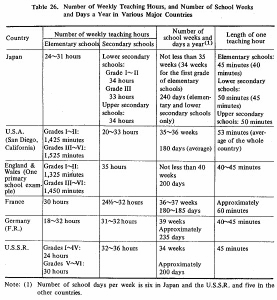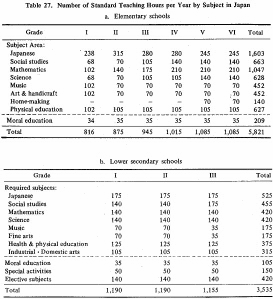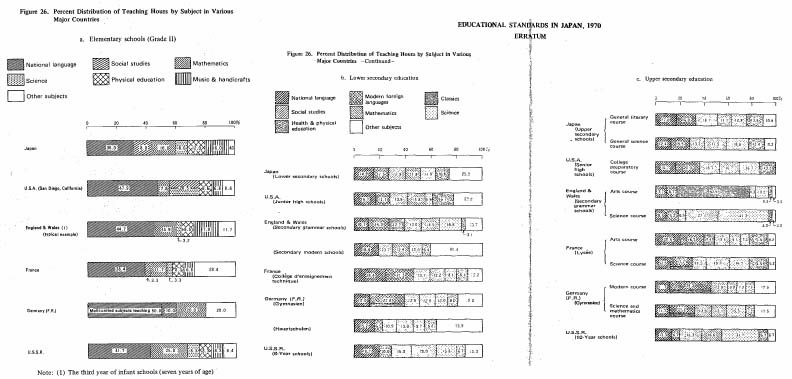| Home > Policy > White Paper, Notice, Announcement > White Paper > EDUCATIONAL STANDARDS IN JAPAN 1971 > CHAPTER |
||
Teaching hours in Japanese elementary, lower secondary, and upper secondary schools are prescribed by the Enforcement Regulations of the School Education Law and by the government's courses of study.
The minimum number of school days per year is prescribed as 240, and the minimum number of weeks for the instruction of teaching subjects and morals is 35(34 for the first grade of elementary schools). As for teaching hours in elementary and lower secondary schools, minimums had previously been prescribed, but in the latest revision, a standard number of teaching hours are presented instead of a minimum number. The standard length of one teaching hour is prescribed as 45minutes for elementary schools and 50 minutes for lower secondary schools, but this standard length may be shortened to 40 and 45 minutes respectively.

Note: (1) Number of school days per week is six in Japan and the U.S.S.R. and five in the other countries.
The minimum number of teaching hours is decided by the central
government in France and the U.S.S.R., and by the Ministry of Education in each
state in West Germany. In the states of the U.S.A. and in England and Wales,
the minimum number of school days per year is prescribed, but there are no regulations
as to the minimum number of teaching hours.
In Japan the total standard number of teaching hours is relatively balanced among three groups of subjects; i.e., literary subjects, science-related subjects, and subjects related to arts and physical education. It is to be noted that more teaching hours are allocated to subjects related to music, fine arts, and physical education in Japan than in the other major countries.

Looking ahead to figure 26, one sees that in the major countries, during thesecond year of elemcntary school, the largest number of teaching hours is allocatedto national language instruction. This is especially striking in the U.S.A., Englandand Waies and the U.S.S.R. Mathematics is also given a considerably higlnpercentage of teaching hours in the U.S.S.R. and West Germany. It is to be notedthat in the U.S.S.R. social studies is not offered. In England and Waies and France,subjects other than -those cited are given a very high proportion of teachnng hours.This is due to the fact that in England and Waies religious education (l2.l%) and inFrance self-study (16.7%) is provided.At the lower secondary level, teaching hours are distributed comparativelyevenly among all subject in the U.S.A. and Japan, while in the European countriesthe subject upon which emphasns is placed differs from one country to another,with a non-uniform distribution of teaching hours among subjects. In the secondarymodern schools of England and Waies and the Hauptschule of West Germany, bothof which emphasize vocational education and practncal activities, "other subjects"are given a proportionately large number of teaching hours.At the upper secondary level, there are big differences in thednstribution of teaching hours among subjects between Countries and also betwecnstreams or departments within each country. The differences between streams ordepartments are especially marked in European countries. In Japan, an alinost equalnumber of teaching hours are allocated to .language-related subjects andscnence-related subjects in both general and vocational courses just as was shown tobe the case at the lower secondary level. This shows that the allocation ofteaching hours among areas in Japan is more balanccd than in Europcan countries.Other recent trends in the secondary schools of other countries include anincrease in the emphasis placed upon science, mathematics and foreign languages;an increase in the number of teaching hours allocated to physical education due toa rediscovery of its importance; considerable reduction in the emphasis placed onthe classics and a decrease in the number of schools which require allstudents to complete such subjects. There are similar tendcncies in Japan. In thenew course of study for lower secondary schools the number of teaching hoursallocated to mathematics and physical education has been increased by approxi-mately 10% and 20% respectively over the numbers prescribed in the existingcourse of study.

Note: (l) The third year of infant schools (seven years of age)
| Back to Top | MEXT HOME |